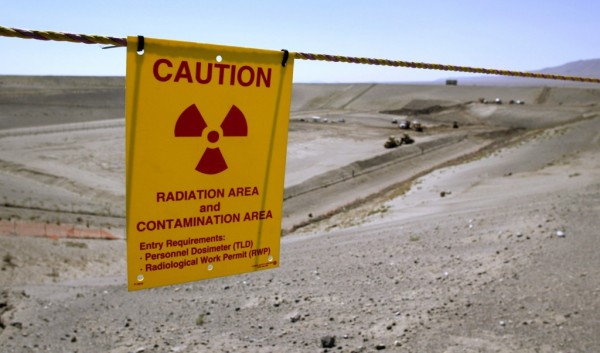forum
library
tutorial
contact

Six Hanford Tanks Leaking Radioactive Waste
by Joel ConnellySeattle Post-Intelligencer, February 22, 2013
|
the film forum library tutorial contact |

|
Six Hanford Tanks Leaking Radioactive Wasteby Joel ConnellySeattle Post-Intelligencer, February 22, 2013 |
Despite all the dollars spent, the U.S. Dept. of Energy has discovered that
six old, World War II-vintage waste tanks are leaking intensively radioactive sludge.
 A half-dozen old single-shell waste tanks at Hanford are leaking highly radioactive sludge into soil at the Eastern Washington nuclear reservation, Gov. Jay Inslee learned in a briefing Friday from U.S. Energy Secretary Steven Chu and senior DOE brass.
A half-dozen old single-shell waste tanks at Hanford are leaking highly radioactive sludge into soil at the Eastern Washington nuclear reservation, Gov. Jay Inslee learned in a briefing Friday from U.S. Energy Secretary Steven Chu and senior DOE brass.
"Secretary Chu advised me we have six leaking single shell tanks at the Hanford site, not just one as was previously reported," Inslee reported. "The amount of leakage varies from tank to tank."
"There may be more," he added.
The 560-square mile Eastern Washington reservation needs a "new action plan," in the governor's opinion, to clean up radioactive waste that dates from the World War II Manhattan Project.
A "stabilization" program on the 149 single shell tanks was completed in 2005, but thousands of gallons of sludge remain even though liquids were pumped out of the tanks.
The tank "farms" once held 53 million gallons of radioactive waste, the legacy of 45 years spent manufacturing plutonium for the Manhattan Project and Cold War-era nuclear weapons. Plutonium for the atomic bomb dropped on the Japanese city of Nagasaki came from Hanford.
"The secretary (Chu) is very clear that there is no imminent public health threat with these leaks," Inslee told reporters.
The Hanford Reservation was built along banks of the Columbia River so its reactors would have a ready source of cooling water. A part of the reservation is now the Hanford Reach National Monument, designated by President Clinton. It is the only undammed stretch of the river between Bonneville Dam and the Canadian border.
The Columbia River's last big wild migrating fish population, the fall chinook salmon run, spawns in the Hanford Reach. The stretch of river is know for its wildlife populations, large numbers of pelicans, and the white bluffs on the north side of the river.
The large-scale effort to clean up Hanford is nearly a quarter-century old. Hanford was the state's largest recipient -- more than $1 billion -- of federal money under President Obama's stimulus program. The money went to begin construction of a vitrification plant that will eventually turn radioactive waste to glass and permanently isolate it from the environment.
But the waste is, as Inslee described it, a "witches' brew" and treating it poses a major technical challenge. The vitrification plant is years behind its original schedule and far over budget. Before the project can go ahead, the DOE plans a full-scale mockup demonstration to show that its technology can work. "This is something never before done in human history," said Inslee.
In the meantime, the state will insist on additional monitoring, and wants sludge pumped out of the old single-shell tanks and into double-shell tanks. The first tank to be confirmed as a leaker -- T-111 -- still contains more than 440,000 gallons of radioactive sludge. It was built originally in 1943-44.
"We will have to have a system for removing the waste in the most expeditious way possible," Inslee said. A few moments later, however, he added: "That could take five years or more than five years."
The Department of Energy has tried a variety of approaches and contractors at Hanford. Under the Bush I administration, Energy Secretary James Watkins deployed "tiger teams" from headquarters to shape up management of waste sites. Then, the Clinton administration reversed course and decentralized management of America's nuclear weapons sites.
Hanging over the Hanford cleanup, and coming in a week's time, is a sequestration of federal spending that will cut federal programs across the board -- from rangers in Olympic National Park to aircraft controllers at Sea-Tac to civilian Army and Navy personnel at Puget Sound-area bases.
"To see Hanford workers furloughed at the exact moment we have additional leakers out there is completely unacceptable," Inslee said.
Eastern Washington is represented in Congress by two senior Republican lawmakers. Rep. Cathy McMorris-Rodgers, R-Wash., chairs the House Republican Conference. Rep. Doc Hastings, R-Wash., whose district includes Hanford, is chairman of the House Energy and Commerce Committee.
Neither has said anything about Hanford and sequester. The House GOP leadership has indicated that it will allow the cuts to take effect. A frustrated freshman U.S. Rep. Denny Heck, D-Wash., has commented: "The appropriate parties are not even talking."
President Obama has called Republican leaders in recent days. After meeting with the President, along with other governors, Inslee said Friday: "Unfortunately, he has not found anyone to deal with across the aisle."
learn more on topics covered in the film
see the video
read the script
learn the songs
discussion forum
